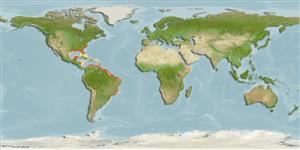>
Eupercaria/misc (Various families in series Eupercaria) >
Sciaenidae (Drums or croakers)
Etymology: Menticirrhus: Latin, mentum = beard, chin + Latin, cirrus = curly.
Environment: milieu / climate zone / depth range / distribution range
Οικολογία
Θαλασσινό(ά); Υφάλμυρο βενθικό(ς); ωκεανόδρομο(ς) (Ref. 51243); εύρος βάθους 10 - ? m. Subtropical; 38°N - 33°S
Western Atlantic: Virginia, USA and the continental coast of the Gulf of Mexico to Rio Grande del Sur, Brazil.
Length at first maturity / Μέγεθος / Βάρος / Age
Maturity: Lm 23.0, range 20 - ? cm
Max length : 48.3 cm TL αρσενικό/απροσδιόριστο; (Ref. 40637); common length : 30.0 cm TL αρσενικό/απροσδιόριστο; (Ref. 3702); μεγ. δημοσιευμένο βάρος: 1.4 kg (Ref. 40637)
Grayish brown above, shading to silvery below, no prominent bars. Lower jaw has single, stout, peg-like barbel with pore at tip. Scales on belly smaller than those on side (Ref. 26938).
Occurs usually in coastal waters over sandy and muddy bottoms; juveniles are abundant in the surf zone. Sometimes enters estuaries. Feeds mainly on worms and crustaceans. Excellent food fish (Ref. 26938).
Life cycle and mating behavior
Γεννητική Ωρίμανση | Αναπαραγωγή | Γεννοβολία | Αβγά | Γονιμότητα | Προνύμφες
Robins, C.R. and G.C. Ray, 1986. A field guide to Atlantic coast fishes of North America. Houghton Mifflin Company, Boston, U.S.A. 354 p. (Ref. 7251)
IUCN Red List Status (Ref. 130435: Version 2024-1)
Threat to humans
Harmless
Human uses
αλιεία: περιορισμένης εμπορικότητας; αλιεία αναψυχής: ναί
Εργαλεία
Special reports
Download XML
Διαδικτυακές πηγές
Estimates based on models
Preferred temperature (Ref.
123201): 22.5 - 27.7, mean 24.9 °C (based on 288 cells).
Phylogenetic diversity index (Ref.
82804): PD
50 = 0.5020 [Uniqueness, from 0.5 = low to 2.0 = high].
Bayesian length-weight: a=0.00794 (0.00497 - 0.01270), b=3.05 (2.92 - 3.18), in cm total length, based on LWR estimates for this species & (Sub)family-body (Ref.
93245).
Τροφικό Επίπεδο (Ref.
69278): 3.9 ±0.6 se; based on diet studies.
Ελαστικότητα (Ref.
120179): Μεσαίο(α), ελάχιστος χρόνος για διπλασιασμό πληθυσμού 1,4 - 4,4 έτη (Assuming tm <4).
Prior r = 0.53, 95% CL = 0.35 - 0.80, Based on 1 data-limited stock assessment.
Fishing Vulnerability (Ref.
59153): Moderate vulnerability (38 of 100).
Climate Vulnerability (Ref.
125649): High vulnerability (56 of 100).
Nutrients (Ref.
124155): Calcium = 83.8 [47.1, 161.3] mg/100g; Iron = 0.977 [0.519, 1.751] mg/100g; Protein = 21.4 [19.5, 23.7] %; Omega3 = 0.337 [0.195, 0.549] g/100g; Selenium = 20 [11, 39] μg/100g; VitaminA = 11.8 [4.2, 39.0] μg/100g; Zinc = 0.799 [0.572, 1.159] mg/100g (wet weight);
